Marah J. Hardt's Blog
January 13, 2016
‘Tis the season for seahorse sex
It’s January, and seahorses in the southern hemisphere are full swing into some summer lovin’. And if you’re out cruising the seagrass beds off Australia’s south coast, you might get lucky too, and witness the remarkable act of a female impregnating a male. Seahorses turn the tables on sexual roles.
And while their cryptic coloration makes courting seahorses difficult to see, especially observant divers—like the two researchers who filmed the footage below—might catch a glimpse of the extraordinary aftermath of seahorse sex: a seahorse dad giving birth in the wild:
Yes. That is a pregnant male giving birth to about 150 to 200 baby seahorses that he’s been carrying around, nourishing and protecting, in his belly pouch for about three weeks. During this entire time, he hasn’t had any sex. For these expectant fathers, pregnancy brings with it some strict celibacy.
Here’s why. During “intercourse”, a female seahorse deposits eggs via an oviposter (which looks like tiny phallus protruding from where her belly button would be). This stubby tube extends from her belly, pushed outward by the swelling of eggs inside her, and enters into the male’s open pouch.
In several seahorse species, a horny male shows he is ready for action by flexing his body, pulling tail up towards nose and then straightening out. This serves to fill his pouch with water, ballooning it outwards and showing off the big, gaping cavern where he will nurture the young. (The side effect of this vigorous folding action is that his stretched opening looks an awful lot like a natural form reminiscent of a Georgia O’Keefe).

Male Hippocampus subelongatus, with prominent belly pouch ready to burst with babies. Photographed by Tammy Gibbs. Tammygibbsphotography.wordpress.com.
Females are likely turned on by the site of this enormous chamber, and will commence consummation.
After the female has deposited her eggs into his pouch, the male then seals it shut, releasing sperm into the chamber to fertilize the eggs. His pouch then fills with nourishing fluids to bathe the embryos and must remain sealed to prevent seawater—which is fatal to developing young—from getting in. Thus, the three-week dry spell for seahorse action.
But just because there is no sex, doesn’t mean they don’t flirt. In fact, for White’s seahorse (Hippocampus whitei)—the species caught on film above—a pair of lovers continues to meet and greet each other every day throughout the pregnancy.
Though flirtatious, this formal courtship is straight out of a Jane Austen novel, complete with proper etiquette.
A male arrives at a designated “greeting” spot at dawn; the female then makes her entrance and quickly swims to the male while the two “blush” colors at one another. Each seahorse then grasps a blade of grass with their delicate curving tails, and begins to circle around in the same direction, the male making the larger outer circle around the female. Periodically, they release their grasp and swim side-by-side, tails often entwined, along the seagrass meadow, like two lovers out for a morning stroll. Then, they repeat.
This happens for several rounds, and then the two part, returning home (like proper lads and ladies), until the next morning.
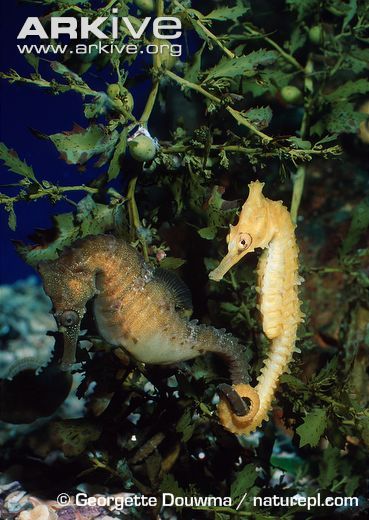
A pair of White’s seahorses having their morning dance. Photo via ARKIVE.org (c) Georgette Douwma
Staying with the same partner is, well, rather aberrant behavior for any species. Nowadays, genetic tests have shown that only a handful of species are really monogamous. But White’s seahorses are one of them (at least for a season), with males and females staying true, one sexual bout after the other from October to about April.
One of the potential reasons for this is that having a dedicated partner helps coordinate some perfectly timed sex. For males, they need a female with ripe eggs, ready to go, within a few hours after giving birth in order to fully maximize the reproductive season. Females, on the other hand, have a limited window of only a few days to hold onto their eggs once they have hydrated them—if a male doesn’t show, she has to dump the whole batch.That’s a huge energetic waste on her end.
By staying closely bonded, females can regulate egg development to correspond to when their male will be ready to receive another round. The male ensures he has a female in synch with his birth schedule; the female gets a male who shows up on time.
Only when the male has just given birth will he signal—via the vigorous body flexing—that he is ready to take things beyond the morning dance ritual. Courting the female may take several minutes or even hours, depending. Should he be successful, however, he will receive a pouchful of eggs…and commence his journey through pregnancy once again.

White’s seahorse female transferring eggs to male. Photo via ARKIVE.org, (c) Rudie Kuiter/ gettyimages.com.
As soon as those babies are out the door, the male is ready to go again—pretty impressive for someone who has just given live birth to dozens of young. With a mating season of only about 6 months, pregnancies are stacked back to back—an endeavor made easier by the fact that his mate is patiently waiting for him back at lovers lane.
The next time you gaze out across the shimmering sea, consider this: somewhere out there, right at that very moment, you can bet there is some creative (if not kinky) sex going on.
Throughout 2016, Sex in the Sea will bring you updates about who is getting down to business each month. A calendar to accompany the stories is in the works, but for now, check back regularly to stay on top of the hanky-panky happening beneath the waves as we circle round the sun.
September 14, 2015
Ribbon eels: when your junk is in the trunk
The Central Florida Aquarium Society recently posted this mesmerizing footage of a ribbon eel undulating across the seafloor. While the eel looks like something out of an Gymnastic’s ribbon routine, for this fish, it is simply swimming. It just looks fancy. It’s the striking colors and unusually elongate and narrow body that creates the effect. And as noted, it’s part of why the ribbon eel is considered unique. But there’s more to this fish’s novelty than meets the eye.
For one thing, the ribbon eel is a sex-changer. The gorgeous blue and yellow fish in the post is a male, likely a mature one. If it lives long enough, it will morph into a female, blushing golden all over. Soon after, it will spawn and then die. But that’s not actually all that unique. Lots of marine species transition from male to female, including most of the shrimp in your shrimp cocktail. What is unique is that ribbon eels are one of the only vertebrates that has its gonads located BEHIND its anus…
Yes. That’s right. It stores the family jewels in its tail, which is an aberrant (if not totally unique) arrangement for any vertebrate. Nature’s always got a first.
According to Fishelson 1990, there is an interesting consequence of this anatomical situation:
“This means that in Rhinumuraena spp. during reproduction, the sex cells within the gonad will move anteriorally towards the respective openings, and not posteriorally as in other fish.”
Translation: unlike every other known vertebrate, with sperm and eggs flowing down and out, the ribbon eel’s gametes swim upstream, towards it’s head. Which makes one (ok, me) wonder for a moment if that’s why they are so unusually long: otherwise they’d be spawning themselves in the face all the time. Then I remember they are fish, swimming in ocean, which has a rather strong diffusive effect. It would take quite a bit of explosive force to shoot gametes with any directionality. Still, for the ribbon eel, a little extra length certainly doesn’t hurt, given their unique organ configuration.
Reference: Fishelson,L. “Rhinomuraena spp. (Pisces: Muraenidae): the first vertebrate genus with post-anally situated urogemtal organs.” Marine Biology 105: 253-257.
More weird and wild sex lives of marine life to come as Sex in the Sea continues its journey towards publication February 9, 2016. Pre-orders now available online!
September 12, 2015
Pre-orders now available! (it’s all about the build up)

Now Available for Pre-Order!
Behind this blog’s recent silence there’s been a whole lot of writing going on. As proof, I’m thrilled to announce that Sex in the Sea is now available for pre-order on Amazon and Barnes and Noble!!! It’s been a long journey, but the finish is in sight…
For those of you interested in shaking things up a bit for Valentine’s, this is the gift for you. The hardcovers will be available in the flesh February 9, 2016, but order now to secure your copy before they slip away!
Here’s a bit more about what’s between the sheets:
It smells like sex. I couldn’t shake that somewhat disturbing thought as I floated at the surface watching the moonlight glisten off the ever-widening slick—the residue of the night’s intimacy. The distinct, musty odor was undeniable. I guess I shouldn’t have been so surprised—after all, I had just spent the past two hours watching corals spawn. But that event looked so unlike sex, I never expected the aftermath to smell like it. As I pulled strands of mucus-y coral goo out of my hair, I caught the eye of the other researchers similarly engaged in de-spawning themselves. We smiled at one another with a knowing look. There is a certain level of bonding that occurs when floating amidst the leftovers of one of nature’s biggest orgies.
******
Forget the Kama Sutra. When it comes to inventive sex acts, just look to the sea. There we find elaborate mating rituals of armored lobsters; giant right whales engaging in a lively threesome; full moon sex parties of groupers and daily mating blitzes by wrasse. Deep-sea squid perform inverted 69s, while hermaphrodite sea slugs link up in giant sex loops. From doubly endowed sharks to the maze-like vaginas of some whales, SEX IN THE SEA is a journey unlike any other to explore the staggering ways life begets life beneath the waves.
A colorful window into the kinky and diverse world of sex under the sea, SEX IN THE SEA has a noble intent. Beyond a deliciously voyeuristic excursion, this book uniquely connects the timeless topic of sex with the timely issue of sustainable oceans. Through overfishing, climate change, and pollution we are disrupting the creative procreation that drives the wild abundance of sea life we all rely upon. With wit and scientific rigor, Hardt introduces us to the wet and wild sex lives of ocean life and the innovative solutions that promote rather than prevent, successful sex in the sea. Part science, part erotica, SEX IN THE SEA discusses how we can shift from a prophylactic to a more propagative force for life in the ocean. In other words, through titillating tales of sex in sea, this book aims to lure in, captivate, and then motivate a whole new audience to care about ocean conservation.
March 28, 2015
An interlude

Michelangelo’s Pietá. Photo Credit: Paweesit
One of my favorite descriptions of all time is Irving Stone’s Michelangelo standing in the quarry at sunrise, gazing at raw chunks of marble in the early dawn light. He is peering inside the stone to discover the figure that lays within, the man or woman or angel that needs to be freed through his hammer and chisel.
He was not creating these sculptures, but releasing what he believed already existed within. I realize that with my own book, I have the same feeling, a sense that there is a story to be released. Yet, unlike Michelangelo, I first have to build the blocks of marble, filling endless white pages with words that will ultimately be carved away. It is a process in two stages, and truth is, I like the carving best.
But first, I must create what needs to be chiseled into form. I’m under no allusions that Sex in the Sea is anything approaching a work of art such as that of the Pietá, but with some luck, I hope tell a story that has long been waiting to be told.
The blog is momentarily quiet as the building process continues, hammer and chisel at the ready. Stay tuned.
February 17, 2015
Twitter feed from Real Scientists!
 Last week, in celebration of the lead up to Valentine’s Day, I had a blast curating the Real Scientists twitter feed. Fantastic community, smart questions, hilarious sexseapuns. From mass synchronized spawning in corals, to lobster love potions, to Right whale threesomes, we covered a lot of ocean. But don’t worry- the tales are captured in this Storify! (for better viewing and in chronological order starting Feb 8th through Valentine’s Day go to this link: Marah Hardt Talks Sex in the Sea)
Last week, in celebration of the lead up to Valentine’s Day, I had a blast curating the Real Scientists twitter feed. Fantastic community, smart questions, hilarious sexseapuns. From mass synchronized spawning in corals, to lobster love potions, to Right whale threesomes, we covered a lot of ocean. But don’t worry- the tales are captured in this Storify! (for better viewing and in chronological order starting Feb 8th through Valentine’s Day go to this link: Marah Hardt Talks Sex in the Sea)
Below is the Storify in reverse!
Tweets about from:realscientists since:2015-02-08 until:2015-02-15
Have a look to catch up on your sexseatriva and other fun stories of sex in the sea. Huge thanks to all the admin and great curators over at Real Scientists, a fantastic resource for science on the web.
February 14, 2015
A Little Swing for Your Salty Sex
In honor of Valentine’s Day, I capture here two of my favorite loves: Swing & my research on SEX IN THE SEA!
Cole Porter’s Lyrics from Let’s Do It! (starting at about 1:58! especially!)
…
Romantic sponges, they say, do it
Oysters down in Oyster Bay do it
Let’s do it, let’s fall in love
Cold Cape Cod clams, ‘gainst their wish, do it
Even lazy jellyfish, do it
Let’s do it, let’s fall in love
Electric eels I might add do it
Though it shocks ’em I know
Why ask if shad do it – Waiter bring me shad roe
In shallow shoals English soles do it
Goldfish in the privacy of bowls do it
Let’s do it, let’s fall in love!!!!
December 14, 2014
All Female bone-devouring worms fancy dwarf males, except one
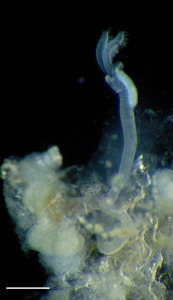
A close-up view (scale: 0.25 mm) of a male Osedax priapus dissected from a bone. Credit: Greg Rouse
Thrilled to have my first post up on the mighty and brilliant Deep Sea News site. Click the link to dive into the sex lives of extreme scavengers of the deep, Osedax. They are bone-devouring worms that lack a mouth or gut and until recently, seemed to have a thing for micro-males. A new study published by the fantastic deep-sea invert expert, Greg Rouse, at Scripps, describes a new species where, lo and behold, the males have escaped the evolutionary clutches of enslaved stunted existence to develop into free, independent beings that use their bodies as a giant phallus. Rock on deep sea sex.
November 19, 2014
R.E.S.P.E.C.T the BOFFFS: Big Old Fat Fecund Female Fish
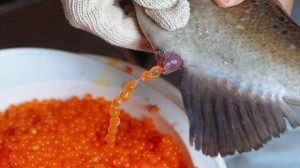
“milking” salmon for her roe. Photo: Tim Grey via Goodfood.com
They are Big. They are Fat. They are remarkably Fecund. They are Female. And they are Fish. Introducing the BOFFFF and why scientists are saying she deserves more respect. Hint: it has to do with her enormous egg-making capacity and the lack of lunch-box let downs for her developing offspring. More on my guest blog on Scientific American: Catching Big Mama Fish Curbs Ocean Fertility.
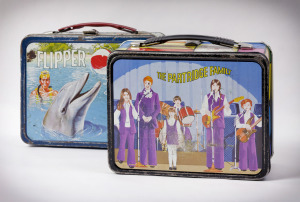
Flipper lunchbox via Randy Heintz, Flickr.
September 25, 2014
Coral Hybrid: Sex Gone Awry or Saving Grace?

Elkhorn coral spawning. Photo credit: Mark Vermeij
Excited to have my second Guest Blog on Scientific American about a favorite subject: coral mass spawning. Huge thanks to Dr. Nicole Fogarty at Nova Southeastern University for sharing her stories and Dr. Mark Vermeij at CARMABI for fantastic images.
July 16, 2014
Lolita of the Sea(weed): Update
******So complex and utterly alien are the sex lives of seaweeds that my original blog post on the subject from April required some updating. With much thanks to Dr. Chopin for editing assistance, here’s a revisit to the scandalous sex life of a seaweed. ******
[image error]
Vladimir Nabokov’s Lolita
Lo-lee-ta: the tip of the tongue taking a trip of three steps down the palate to tap, at three, on the teeth. Lo. Lee. Ta.
One of the greatest opening lines of all time, this is the introduction to Vladimir Nabokov’s brilliant and disturbing Lolita. A long-held favorite of mine, I was utterly thrilled when seaweed guru Dr. Thierry Chopin referred to this modern classic as a model for understanding the complex and rather shocking sex life of a common edible seaweed.
I know what you may be thinking: seaweeds have sex lives?

The red seaweed called dulse and sugar kelp, a brown seaweed, seen in abundance at low tide along the rocky shore of the Bay of Fundy, New Brunswick, Canada (photo credit: Thierry Chopin)
Yes. Don’t let those passively swaying fronds fool you. Despite their rather limp appearance, seaweeds (also commonly known as marine macroalgae) are raging sex machines, with some of the strangest and most creative forms of sexual reproduction on the planet. A catch-all group that lumps together remarkably diverse species (green seaweeds are more closely related to trees than they are to brown seaweeds, for example, which are more closely related to fungi), it is no surprise that they display an enormous range of reproductive strategies. Chopin wrote a debrief here on seaweed sex after our interview for Sex in the Sea; he’s insisting that I must include a chapter (or two!) on seaweed reproduction, and I heartily agree. Here’s why: seaweed cultivation is big. Globally, seaweed farmers grow 23.8 million tonnes a year—nearly 50% of all the world’s ocean farming worth $US 6.4 billion.

Large scale seaweed (kelp) cultivation in Sungo Bay, China. Note seaweeds grown integrated with the cultivation of several invertebrate species (oysters, scallops, abalones and sea cucumbers) (photo credit: Thierry Chopin).
Long recognized as a healthy and delicious food in Asia, seaweed farming is gaining traction in the west, including in Canada, Chile, Europe, and the USA. And it’s not just food that seaweed bestows; this video provides a great overview of the varied and everyday uses for seaweed.
Fast growing and photosynthetic, seaweeds don’t need to be fed like fish or shrimp; they just need sunlight and nutrient rich waters (which they help keep clean) to grow. They are being tested as natural ways to clean up effluent from fish farms (a key focus of Chopin’s work on Integrated Multi-Trophic Aquaculture), mitigate climate change, and produce healthy and abundant food. But in order for us to grow more seaweeds, we’ve got to know how they reproduce. We need to understand in intimate detail, the intimate acts of seaweed.
Talking with Chopin, it is clear that there is no one “sex life” of seaweeds. Instead, there is an endless fractal-like sexscape with every imaginable permutation: male-female couplings? They got that. Hermaphrodites? Sure. Asexual inter-generational phases? Check. Dwarf females? Yup. Self-perpetuating parthenogenetic gametes alternating with asexual spore germination…they’ve got that too. And, they can also claim, according to Chopin, “old male perverts” and temptress nymphets. Which brings us back to Lolita.
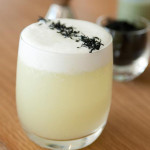
Kelp cocktails, brain child of Bren Smith at Thimble Island Oysters and talented chefs across New York City (photo credit: )
Deciphering the wild life cycles of these remarkable food factories has challenged many a phycologist (note: that’s not a typo for a shrink, but a scientist who studies algae). But, with the help of Chopin’s expertise and anything-but-prude French perspective (and a few kelp cocktails), I’m slowly wrapping my nori around it all. Here, for your summer reading pleasure, is the tantalizing tale of a seaweed named dulse (Palmaria palmata) though “Dolores” would be more appropriate. May your innocent strolls along the seaside never be quite the same again.

An innocent stroll along the seaside (photo credit: windydress via Flickr)
It all starts with the females, who, according to Chopin, are all young and extremely sexually precocious (seaweeds, like many plants, can have separate sexes, with individuals maturing as males or females). At just a few weeks old, female dulse have fully mature sexual organs called trichogynes which are slender tubes that reach out to receive the male gametes.
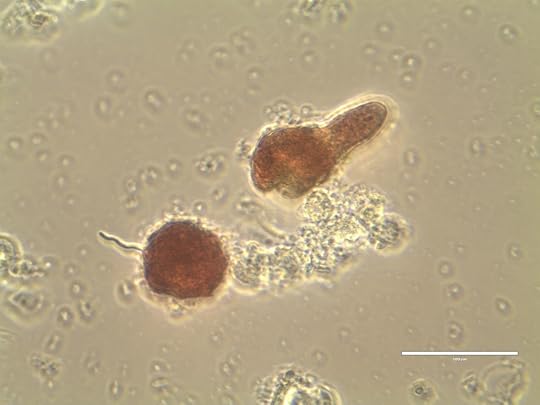
Microscopic mature female gametophyte (left) of the red seaweed Palmaria palmata (dulse) with trichogyne filament visible on the left. On the upper right, a young male gametophyte just starting to elongate. The scale bar at the bottom right represents 0.1 mm (photo credit: Constanza Chianale).
But, these blossoming beauties (what Chopin refers to as the “Lolitas”) are also microscopic in size, a tiny disc less than a millimeter in diameter. For decades scientists searched for the mature females in vain, only discovering them through some accidental lab experiments in the 1980s. The much larger mature males were more easily spotted in the field (but specialists in the lab still had to confirm identification), while the females remained a mystery, their small size but one contributing factor…
…the other reason was that they were rapidly buried alive by their own offspring. But, we’ll get to that.
First, it’s important to note that male dulse, like in some other species we know, don’t grow-up quite as quickly as their female counterparts. In fact, males the same age as mature females are but young, pre-pubescent boys, incapable of satisfying the females’ desires. Males of the previous generation, however, don’t have this problem. Having weathered a winter, so to speak, these older males are more than capable of giving the females what they want: a shower of seed. These older males readily release their tail-less, sperm-like spermatia into the water, relying on the currents to whisk them atop the thin crust of the female. If just one lucky spermatium makes contact with a female’s trichogyne, fertilization can progress.

A general life cycle of dulse, adapted from van der Meer J.P. and Todd E.R. 1980. The life history of Palmaria palmata in culture. A new type for the Rhodophyta. Canadian Journal of Botany 58:1250-1256
But the product of this union is rather unusual. As Chopin explained it in Lolita terms: “So, say a female dulse, Dolores, receives a spermatium from an older male dulse, Humbert. When this happens, the fertilized egg develops into what looks like a mini Humbert, but is actually an asexual sporophyte that starts to sprout from Dolores’ thin surface.”
Let’s call that sporophyte, Pat. Unlike Dolores and Humbert, which are gametophytes—the gamete-producing part of the seaweed’s life cycle—Pat produces asexual spores. As it develops, Pat overgrows the dwarf female Dolores from which it sprang, swallowing her up as if she never existed. That’s really why scientists couldn’t find the mature females of the dulse world: they were overgrown by their offspring’s sporophyte fronds.

Mature sporophyte of the red seaweed Palmaria palmata (dulse), with darker sori of spores (thousands grouped in quadruplets) (photo credit: Thierry Chopin)
Once Dolores is squashed, Pat, having reached a large size, then produces many sets of quadruplet spores, grouped by the thousands to form dark spots, called sori (these dark spots make this the easiest stage of the life cycle to recognize). Every quadruplet has two spores that develop into boys and two that become girls. And these are the gametophytes that can sexually reproduce again.
But the girls can reproduce far sooner. They, like the overgrown Dolores, are nymphets, reaching sexual maturity within a few weeks. As Chopin puts it “and the boys being boys, the girls have to court the males from the older generation. Thus, it is generations after generations. And that’s where things get all Nabokov.”
So, the cycle of inter-generational coupling continues, as these new Lolitas court the males of Dolores’ generation, who are finally sexually mature (eight to twelve months later). Within the same generation, there is no way for one of these nubile females to mate with a guy her own age (of course, this also means she can’t mate with her brothers, which could be why the dulse does it this way).
Chopin concludes: Precocious sexuality of little Palmaria females with their mother’s male siblings, who have finally reached maturity, condemns them to being buried by their offspring’s overgrowing holdfast on the same rocky spot they occupy, hence leading people to believe for a very long time that they never existed!
It’s a female-mates-with-mother’s-brother-bares-asexual-offspring-that-smothers-mother world out there for dulse. Figuring out this convoluted life cycle was an important step forward in our ability to cultivate this popular food—and learn how other seaweeds might be doing it.
Of course, there’s another bonus to understanding seaweed sex, besides the opportunities for food production, ecosystem restoration, and other advantages: whatever drives their sex could help our own sex drive, too. Something to consider next time you crunch through that sushi roll.



